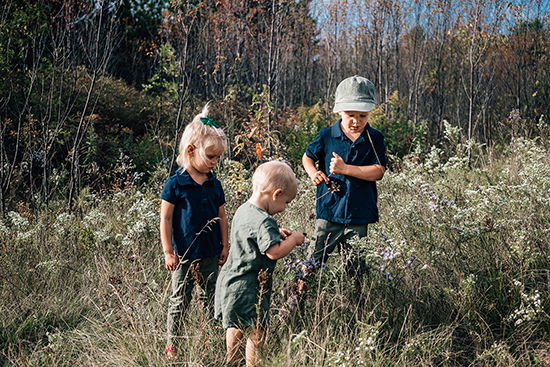What to Look For on a Fall Exploration of God’s Creation
Photo by Jessalyn Prins Photography
Hey there, Creation Explorer!
We’re currently in southern Ontario, Canada, and it’s fall here. The trees are clothed in reds, yellows, and oranges, and the autumn flowers are in full bloom—it’s so beautiful! Fall is a great time to get out and go explore God’s creation like we’re doing.
And here are some creature friends you can watch for while you’re out exploring:
-
Squirrels and Chipmunks
These fun creature friends are everywhere this time of year, gathering and storing food for the winter (this is called “caching”). You don’t need to go far to see one or more. Watch for fat cheeks stuffed with goodies (a chipmunk’s cheeks can stretch to three times the size of its head!) and see if you can find a squirrel burying its stash.
Did You Know?
Squirrels make “jerky” (they dry mushrooms in the sun!) and “candy” (they chew holes in sugar maples and lick up the dried sugar from the sap). You can learn more about squirrels in this article. - Salamanders
These amphibians like it cool and damp, so now is a great time to go searching for salamanders. You can hunt for them under rocks, logs, and piles of leaves, around wetlands of any kind, particularly right at the shoreline and under low-lying bushes. The best time to find them is at night or on rainy or cloudy days. If you find one, avoid picking it up unless you are wearing gloves, as amphibians are sensitive to the oils, salts, and heat from your hands.
Did You Know?
Salamanders love North America. One-third of the known species are found here and, if you live in the Appalachian Mountains region, you have the highest concentration of salamander species on the continent. - Migrating Birds
Many bird species are heading south for the winter (this is called “migrating”), so you may notice some new birds at your feeder. Here are a few to keep an eye out for this fall:- Turkey Vultures
These scavengers gather in large groups and together head for Mexico. Look for a flock of large black birds soaring on warm air pockets. - Canada Geese
These waterfowl also gather in flocks to migrate. Most people know them by their V-shaped formation. This shape helps reduce drag, making it easier for those behind the leader to fly. The leader at the front of the V swaps out when he or she gets tired. - Ruby-Throated Hummingbirds
These tiny little birds travel from Canada all the way to Central America and Mexico for the winter. Spot them sipping from the last of the fall flowers or grabbing a bite at your hummingbird feeder.
Four billion birds will migrate from Canada to the United States this fall. - Turkey Vultures
- Woolly Bear or Wooly Worm Caterpillars
These caterpillars are brown, black, and very fuzzy. They’re the larvae of the Isabella tiger moth, a brownish-orange moth with black spots. The caterpillars freeze solid through the winter, and when temperatures rise in the spring, they thaw and emerge as moths!
Did You Know?
A town in our home state of Kentucky has hosted a woolly bear festival every year for 34 years. - Green Darner Dragonfly
These bright-green-and-blue dragonflies migrate from Canada down south, where they overwinter. Watch for swarms of them around wetlands, hunting moths, butterflies, mosquitos (yay!), and even other dragonflies. They can fly incredibly quickly, cruising along at 11 mph (18 km) and having bursts of speed up to 37 mph (60 km). Unlike most flying creatures, green darners can fly up, down, sideways, backward, and they can hover.
Did You Know?
Dragonfly eyes have 30,000 separate lenses giving them incredible vision. - Mushrooms
The dampness of fall means mushrooms sprout everywhere. Look for mushrooms and other fungi in damp areas, on the sides of trees, and growing out of fallen logs. There are so many varieties in all kinds of colors, shapes, and textures (a guidebook is helpful if you want to know what species you’re looking at). Consider keeping a count of all the different varieties you can find—you’ll be surprised by just how many there are!
Important Note: Don’t touch or ever eat a wild mushroom without a knowledgeable adult’s permission. In our fallen world, some are very poisonous and could really hurt you!
Did You Know?
The mushroom is the “fruiting body” of a much larger organism. The rest is underground. You can learn more about mushrooms in Season 1, Episode 7 of Schus Off!, “Decomposers,” on Answers TV.
As you enjoy the amazing fall colors, keep your eyes peeled for these creature friends and more. You never know what you might see! Well, we’re off on another adventure! Until next time, remember Revelation 4:11, “Worthy are you, our Lord and God, to receive glory and honor and power, for you created all things, and by your will they existed and were created.”
Have a question or comment? Ask your parents to help you email us at schusoff@answers.tv. We’d love to hear from you!
P.S. Come back next week for another blog entry to join us on our adventures and ask your parents to help you check out Schus Off! An Exploration in God’s Creation on Answers TV.
- © 2024 Answers in Genesis
- Privacy Policy
- Contact
- About




